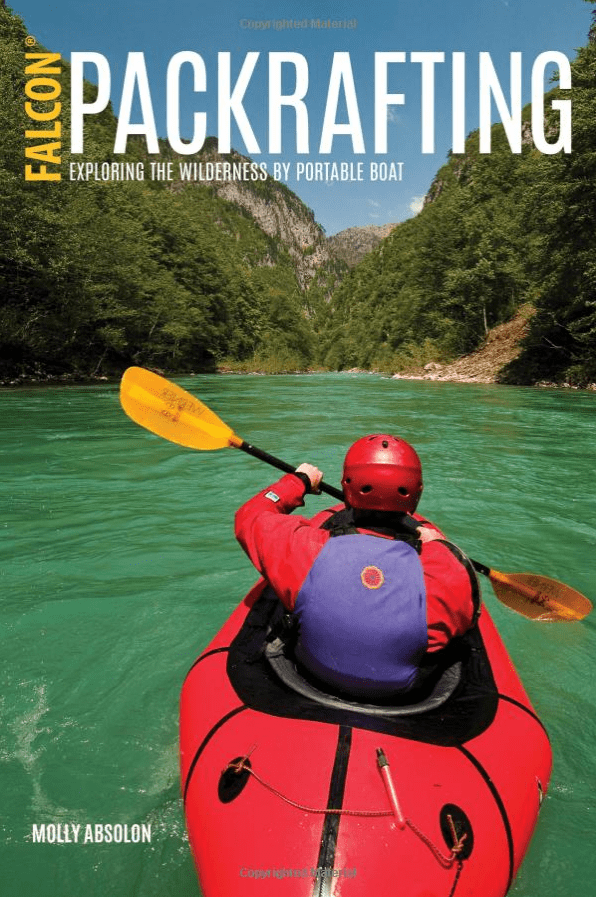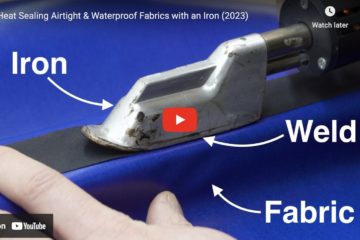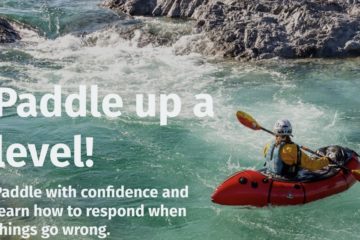
I don’t know how I failed to notice Molly Absolon’s book, “Packrafting – Exploring the Wilderness by Portable Boat” (2017) until now, but I finally picked up a copy last week and read the nearly 250 pages in just a few days.
There are beautiful color pictures on almost every page, which helps to account for the quick read, but it’s also well laid out and easy to find the sections that interest you.
There are chapters on packrafting history, equipment, getting started, paddling techniques, reading river water, river hazards and basic rescue, first aid, leave no trace practices, packraft maintenance/repair/modifications, and trip planning.
Most (if not all) of the information covered in the book could be pieced together from various websites, but here it’s available in an attractive and convenient package that you can refer to offline.
Like a lot of introductory books, its coverage is broad, but not necessarily deep. The author lives in Idaho and it shows – there are three whole chapters dedicated to river paddling, but the word “tide” doesn’t appear, and you won’t find any information about bikerafting or packraft sailing, so bikerafters and coastal paddlers and won’t find it quite as useful as aspiring whitewater paddlers will. There are plenty of books about sea kayaking and bicycle touring, so that’s not a big problem, but it does seem like an oversight considering the amount of space dedicated to non-packrafting specific things like first aid, leave-no-trace principles, and traditional backpacking gear like stoves and water purifiers.
A lot of the paddling techniques and river hazards would be better demonstrated by video, but obviously that’s not possible in a book, so if you’re having trouble visualizing what exactly is happening in one of the photo sequences, I recommend looking up that subject on YouTube, where you’ll find videos covering the different paddle strokes and how to approach different river features like eddies, holes, etc. (look for whitewater kayaking videos, as they’re more plentiful than packrafting videos). The book is a good starting point though, because in order to know what to look up, you first have to find out what you don’t know.
The sections on camping and backpacking are pretty traditional, so if you’re already an experienced backcountry camper you can skip those – especially if you’ve moved on to the world of ultralight backpacking.
The book is written for Americans, so foreigners will struggle to convert distances and weights to sensible measurements, and won’t have much use for some of the trip planning sections, but the author does occasionally allude to a world outside the US, so at least there’s that.
One problem with photo-dominated books about rapidly evolving sports is that they tend to look out of date pretty quickly, and even two years after this one was published it’s starting to show its age. Unless you’re already quite familiar with the various packraft brands and models, however, you probably won’t notice.
So who is this book for? I’d recommend it to:
- Hikers who are thinking about adding packrafting to their trips but don’t have much paddling experience
- Packrafters who don’t have any whitewater experience and want to learn more about paddling through rapids
- Kayakers or canoeists who are curious about packrafting
- Packrafters from outside the USA who are planning a packrafting trip inside the USA
Who should skip this book?
- Experienced packrafters with at least some whitewater experience
I think the bottom line is that we’re still waiting for a comprehensive packrafting bible to be written (something to play the role that “Freedom of the Hills” does for mountaineers, for example), but until that’s published, “Packrafting – Exploring the Wilderness by Portable Boat” is a good place to start learning about packrafting (especially if you plan to do some river paddling). And who knows – maybe future editions of Molly Absolon’s book will grow into that “bible” role.


0 Comments